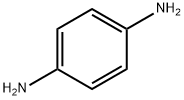A6680812
p-Phenylenediamine , AR,97% , 106-50-3
Synonym(s):
1,4-Benzenediamine;1,4-Diaminobenzene;1,4-Phenylenediamine;4-Aminoaniline
CAS NO.:106-50-3
Empirical Formula: C6H8N2
Molecular Weight: 108.14
MDL number: MFCD00007901
EINECS: 203-404-7
Update time: 2022-07-08
PRODUCT Properties
| Melting point: | 138-143 °C (lit.) |
| Boiling point: | 267 °C (lit.) |
| bulk density | 600kg/m3 |
| Density | 1.135 g/cm3 (20℃) |
| vapor density | 3.7 (vs air) |
| vapor pressure | 1.08 mm Hg ( 100 °C) |
| refractive index | 1.6339 (estimate) |
| Flash point: | 156 °C |
| storage temp. | Store below +30°C. |
| solubility | Soluble in alcohol, chloroform, ether and hot benzene. |
| Colour Index | 76060 |
| form | Powder or Flakes |
| pka | 4.17(at 25℃) |
| color | White, gray, or purple to brown |
| PH Range | NonQ uorescence (3.1) to orange/yellow Q uorescence (4.4) |
| PH | 9 (50g/l, H2O, 20℃) |
| Water Solubility | 47 g/L (25 ºC) |
| Merck | 14,7285 |
| BRN | 742029 |
| Exposure limits | TLV-TWA 0.1 mg/m3 (ACGIH 1989); TWA
skin 0.1 mg/m3 (MSHA and OSHA); IDLH
25 mg/m3 (NIOSH); carcinogenicity: Animal Inadequate Evidence (IARC).
. |
| Stability: | Stable, but oxidizes when exposed to air. Incompatible with oxidizing agents. Store under inert atmosphere. |
| Major Application | Nanoparticles, liquid crystal displays, chemical mechanical polishing, bottom antireflective coatings, electrochromic materials, inks, rubber, hair dyes, cosmetics, treatment of virus skin infection |
| InChIKey | CBCKQZAAMUWICA-UHFFFAOYSA-N |
| LogP | -0.84 at 20℃ |
| CAS DataBase Reference | 106-50-3(CAS DataBase Reference) |
| IARC | 3 (Vol. 16, Sup 7) 1987 |
| NIST Chemistry Reference | 1,4-Benzenediamine(106-50-3) |
| EPA Substance Registry System | p-Phenylenediamine (106-50-3) |
Description and Uses
Paraphenylenediamine (PPD) is a colorless compound oxidized by hydrogen peroxide in the presence of ammonia. It is then polymerized by a coupling agent to produce a color.
4-Phenylenediamine is an azo-dye intermediate; photographic-developing agent; photo-chemical measurements; intermediate in manufacture of antioxidants and accelerators for rubber; laboratory reagent; dye for hair and fur; lithography; photocopying; oils; greases; gasoline; antioxidant/accelerator in the rubber and plastic industry; the hydrochloride is used as blood reagent.
Safety
| Symbol(GHS) |    GHS06,GHS08,GHS09 |
| Signal word | Danger |
| Hazard statements | H301+H311+H331-H317-H319-H370-H410 |
| Precautionary statements | P273-P280-P301+P310-P302+P352+P312-P304+P340+P311-P305+P351+P338 |
| Hazard Codes | T,N,T+,Xn |
| Risk Statements | 23/24/25-36-43-50/53-63-36/37/38-45-40-48/22-67-52/53 |
| Safety Statements | 28-36/37-45-60-61-28A-24/25-23-53-26 |
| RIDADR | UN 1673 6.1/PG 3 |
| OEB | D |
| OEL | TWA: 0.1 mg/m3 [skin] |
| WGK Germany | 3 |
| RTECS | SS8050000 |
| F | 8-10-23 |
| Autoignition Temperature | 567 °C |
| TSCA | Yes |
| HazardClass | 6.1 |
| PackingGroup | III |
| HS Code | 29215119 |
| Hazardous Substances Data | 106-50-3(Hazardous Substances Data) |
| Toxicity | LD50 in rats (mg/kg): 80 orally, 37 i.p. (Burnett) |
| IDLA | 25 mg/m3 |



